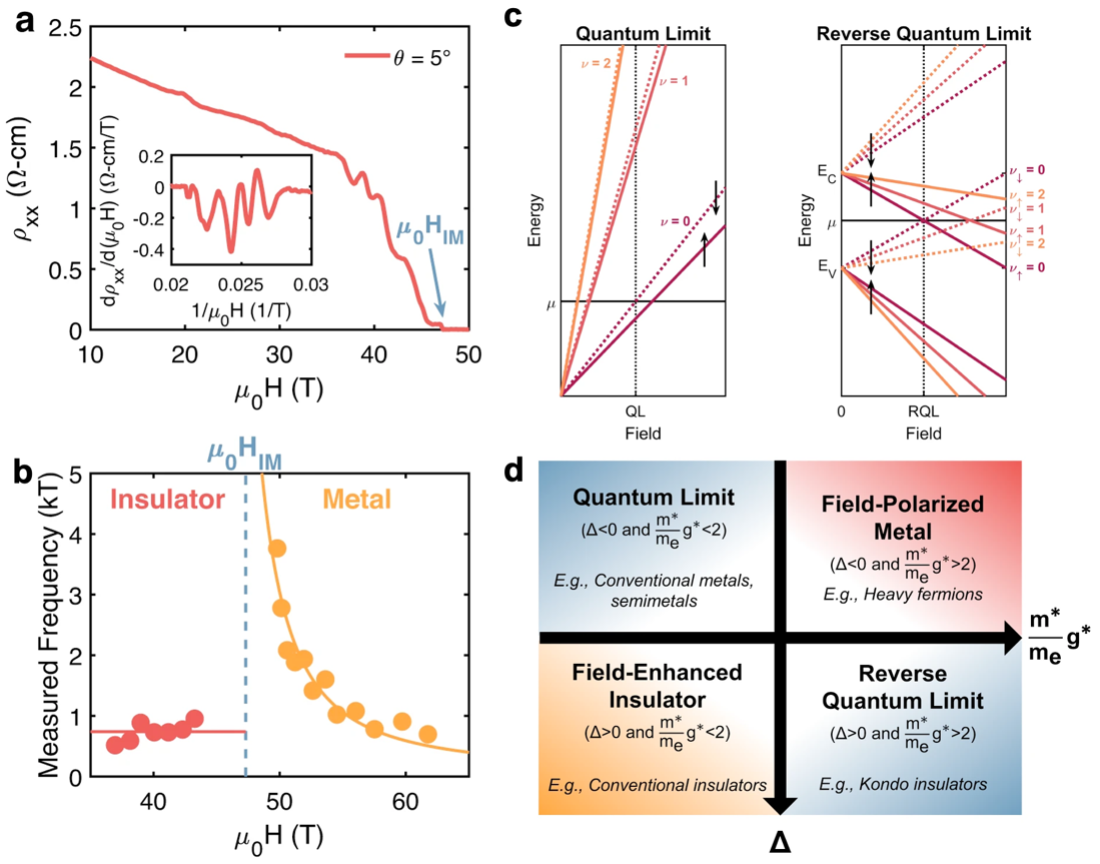PARADIM Highlight #89—External User Project (2024)
C.A. Mizzi, M.K. Chan, Neil Harrison, P.F. S. Rosa, and W.A. Phelan (Los Alamos National Laboratory), and S. Kushwaha, L. Pressley, and T.M. McQueen (Johns Hopkins University)
Strong magnetic fields have dramatic effects on electron motion. In metals, the result is a set of quantized electron orbits, or Landau levels. Above a critical field, only the lowest Landau level is occupied. The resulting quantum limit is highly degenerate and susceptible to instabilities yielding a rich variety of electronic phases including spin- and charge-density waves, fractional quantum Hall states, and excitonic insulators. Unfortunately, access to the quantum limit in the presence of strong electron correlations is typically impeded by the tendency of d/f-electrons to polarize in a strong magnetic field, weakening the interactions.

Figure 1: a) Magneto-resistance showing quantum oscillations in the insulating state and metallic state, respectively. Inset shows derivative. b) Insulating state quantum oscillations have a field-independent frequency of 740 ± 60 T and metallic state quantum oscillations have a field-dependent frequency (H ∥ [100]). Lines are guides for the eye. All measurements at ≈ 650 mK. c) Schematic of the formation of Landau levels and approaching the normal and reverse quantum limit. d) Categorization of possible high magnetic field behaviors as a function of gap and normalized g-factor.
Here, users from Los Alamos National Lab together with PARADIM propose that the strongly correlated quantum limit can be approached in reverse, starting from an insulating state at zero magnetic field. The identified candidate material, ytterbium boride (YbB12), was grown in single crystal form at PARADIM and studied in high magnetic fields at the NHMFL@LANL. The results not only provide access to a novel quantum phase of matter, but also provide a model that naturally explains how quantum oscillations arise in insulators.
The quantum limit in a Fermi liquid, realized when a single Landau level is occupied in strong magnetic fields, gives rise to unconventional states, including the fractional quantum Hall effect and excitonic insulators. Stronger interactions in metals with nearly localized d/f-electron degrees of freedom increase the likelihood of these unconventional states. However, access to the quantum limit is typically impeded by the tendency of d/f-electrons to polarize in a strong magnetic field, consequently weakening the interactions. In this study, PARADIM users propose that the quantum limit in such systems can be approached in reverse, starting from an insulating state at zero magnetic field. In this scenario, Landau levels fill in the reverse order compared to regular metals and are closely linked to a field-induced insulator-to-metal transition. YbB12 is identified as a prime candidate for observing this effect and the presence of an excitonic insulator state near this transition is proposed.
This work introduces the reverse quantum limit, a quantum limit analogue in insulators that occurs when the Zeeman energy exceeds the cyclotron energy, and identifies strongly correlated insulators as a promising platform to explore the rich array of electronic phases expected to arise in the (reverse) quantum limit. The Kondo insulator YbB12 is an ideal system to observe this phenomenon because it possesses an electronic structure that satisfies the reverse quantum limit criterion while having an exceptionally small gap that can be closed by fields accessible in the laboratory. Predictions from the reverse quantum limit model are shown to explain how Landau level indices are pinned to the insulator-metal transition and have a field-dependent frequency in the metallic state. Further, our work suggests that the insulating state quantum oscillations originate from the same bulk Landau levels as the metallic quantum oscillations, and provides important empirical benchmarks for theoretical descriptions of quantum oscillations in YbB12 by demonstrating the central role of the insulator–metal transition.
PARADIM’s Bulk Crystal Growth Facility proves to be the most complete suite of bulk single crystal growth techniques in the nation. The single crystals of YbB12 were grown via the traveling solvent (TS) method under Ar gas atmosphere in the laser diode floating zone furnace. The combination of PARADIM’s synthesis expertise with the NHMFL’s unique high field measurement capabilities enabled the success of this project.
The work was initiated when N. Harrison learned of the successful growths of YbB12 within PARADIM as part of another external user proposal on novel borides.
Data Availability: Details of the single crystal growth can be accessed through the PARADIM Data Collective at DOI 10.34863/25fk-4n21.
C.A. Mizzi, S.K. Kushwaha, P.F.S. Rosa, W.A. Phelan, D.C. Arellano, L.A. Pressley, T.M. McQueen, M.K. Chan, and N. Harrison, "The Reverse Quantum Limit and its Implications for Unconventional Quantum Oscillations in YbB12," Nat. Commun. 15, 1607 (2024). DOI: 10.1038/s41467-024-45801-2
This work was supported by the Department of Energy (DOE) Basic Energy Sciences (BES) project “Science of 100 Tesla.” The National High Magnetic Field Laboratory is funded by National Science Foundation (NSF) Cooperative Agreements No. DMR-1157490 and No. 1164477, the State of Florida, and DOE. C.A.M. and M.K.C. were supported by the LANL LDRD Program, Project No. 20210320ER. M.K.C. acknowledges support from the NSF IR/D program while serving at the National Science Foundation. Any opinions, findings, conclusions, or recommendations expressed in this material are those of the author(s) and do not necessarily reflect the views of the National Science Foundation. S.K.K. acknowledges support of the LANL Directors Postdoctoral Funding LDRD program. This work made use of the synthesis facility of the Platform for the Accelerated Realization, Analysis, and Discovery of Interface Materials (PARADIM), which is supported by the NSF under Cooperative Agreement No. DMR-2039380. Work by the Institute for Quantum Matter, an Energy Frontier Research Center, was funded by DOE, Office of Science, BES under Award No. DE-SC0019331. The authors thank Joe D. Thompson for performing the susceptibility measurements in the Supplementary Information and Boris Maiorov for helpful discussions.







